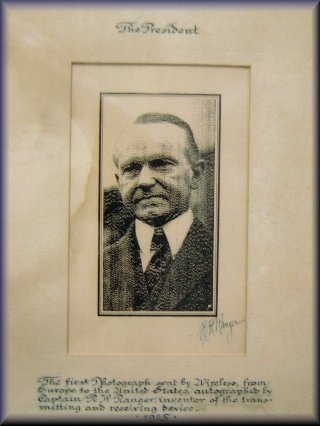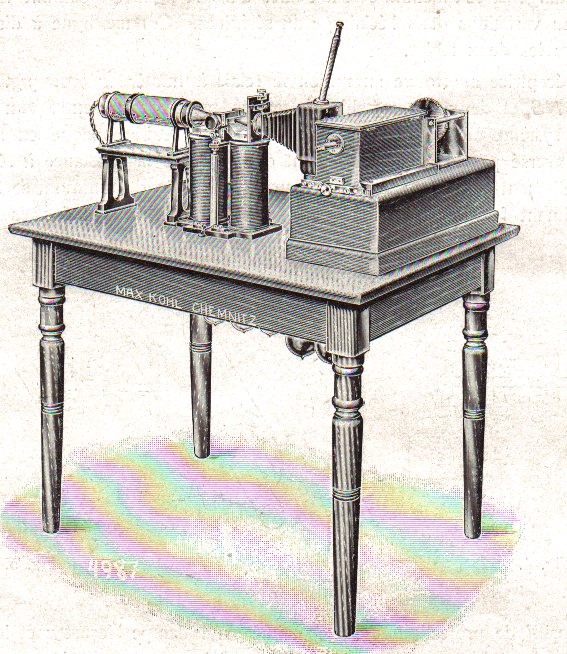A bibliography of references, articles, publications and Books, refer to the history of facsimile
Bildtelegraphie (German) or phototelegraphy means, Te´le´graphie des images, picture telegraphy., = sending pictures via telegraphy, = sending black & white pictures or grayscale photographs. Called also long distance photography
Starting with Alexander Bain´s early work in 1843, and Faraday´s suggestion of the relation between light and elctricity in 1845, many workers have contributed to the art known as facsimile and television.
Bakewell (E.P. 12054, 08 Feb. 1848) build perhaps the first practically working Teleautograph, before Alexander Bain (Patented 1843) his machine shows on the world fair in London 1851, together with Bakewell)
Caselli was possibly the first to produce a successful facsimile system, carrying on tests between Paris and other French cities in 1865.
About Bakewell ( Dinglers Journ., 119, p 75, 1851).
Bain contra Bakewell (Mech. Mag., 48, pp 391, 1848. Mech. Mag., 50, pp. 544, 1849. Mech. Mag., 52, pp,163, 248, 217. 101, 187, 273, 143 and 223, 1850).
Major Benedict Schöffler wrote in 1898 in a nice booklet “Die Phototelegraphie und das Elektrische Fernsehen”, one of the first booklets about Phototelegraphie. (Published by Wilhelm Braumüller, Wien, Leipzig, 1898).
Emmerson Cook ("Pictures by telegraph", Pearson's Magazine, April 1900, Charles Emerson Cook.)
Baker & T. Thorne (Wireless Pictures And Television, practical description of the telegraphy of pictures, photographs and visual images." One of the earliest books on the techniques of transmitting and receiving images by "wireless". 188pp, 99 illus., 50+ footnotes. Much historical material by a pioneer in phototelegraphy, Publisher: Constable & Company
London: Constable & Company, 1926)
Armagnat, Henri (1909; Disbound Pamphlet. 8vo. Offprint from Smithsonian Report for 1908. 197-207 pp. Technical illustrations. Experiments in sending photographs by wire, Publisher: Washington Goverment Printing Office).
Schaffner (The Telegraph Manuall, New York, 1859).
Blavier (Nouveau Traité de Télégrahie Electrique Bd. 2, Paris 1867).
De Moncel (Exposé des Applications de lÉlectricité, Bd 3, Paris 1874)
Zetsche (Handbuch der elektrischen Telegraphie. Bd 1, Berlin, 1877)
In 1900 a distinction was first made between facsimile and television (M. Perskyi Annexes Congress Internationale dÉlectricite, 18th-25th August, 1900, pp. 54-56.),
In 1908 the “Electrician” (Vol. 61, pp. 89-90, May 1, 1908) published an account of Knudson´s system of wireless transmission of photographs.
A study of the first chapter of J. C. Wilsons “ Television” (Television by J: C. Wilson, Pitman & Sons, Ltd., 1937).
E. D. Wilson and V. K. Zworykin´s “Photocells and Their Applications” (Photocells and Their Applications by E. D. Wilson and V. Zworykin, published by John Wiley & Sons.),
Rangers´s first IRE facsimile article (I.R.E. Proc., Vol. 14, No. 2, April, 1926, R. H. Ranger.).

Click on the Picture to expand it
The first photograph sent by wireless, from Europe to the United States, shows the President Calvin Coolidge,
autographed by Captain R. H. Ranger, inventor of the transmitting and receiving device. 1925.
Copyright notice:This photo was placed with permission of the owner, James F. X. Mc IIhinney, Philadelphia, U.S.A.
Do not use or take the image without the permission of the owner.
Korns article in 1924 (E.N.T., Vol. No. 6, pp. 175-187, 1924, A. Korn).
Schroter´s Handbook (der Bildtelegraphie und des Fernsehehens by F. Schroter, published by Julius Springer, Berlin, ).
Korn´s Handbook (PROF. Dr. Arthur Korn und PROF. Dr. Bruno Glatzel, Handbuch der Phototelegraphie und Teleautographie, Otto Nemnich verlag, Leipzig, 1911, 488 pages).
(This Book is one of the best recources about Photofacsimile, from the beginning since 1843 up to 1911, written in German)
Korn (Über gebe und Empfangsapparate zur elektrischen Fernübertragung von Photographien, Physikalische Zeitschrift, n.5 84), 1904, pp. 113-118)
Korn´s Handbook (Elektrische Fernsehphotographie und Ähnliches, Verlag von S. Hitzel, Leipzig, 1904)
Korn´s Handbook ( La telegraphie des images, Je sais tout, Paris, 18 Avril 1907)
Pohl (Die elektrische Fernübertragung von Bildern, Braunschweig, 1910, 45 pp.)
Tschorner (E. P. 13104, 24 November, 1910. appl. 30 May, 1910, since 30. Jun. 1909. in Austria Patented)
Korn Bildtelegraphie (Bildtelegarphie,Sammlung Goeschen, Band 873, Walter de Gruyter, Berlin-Leipzig, 1923, 146 pp.)
Korn and Nesper ( Bildrundfunk, Julius Pringer, Berlin, 1926)
Aisberg (Television et phototelegraphie - principes fondamentaux, preface d'Edouard Belin, Etienne Chiron, 1930, 82 gravures et photos)
Aisberg (E. La transmission des images. Bd. I: Phototelegraphie et television. Paris, Chiron, 1930.
Fuchs ( Die Bildtelegraphie. Berlin, G. Siemens, 1926, Gerhard Fuchs).
Practical Radio (National Radio Institute, Washington D.C., 1926 and 1931)
Charles R. Jones, Handbook (Facsimile, by Charles R, Jones, Rinehart Books, Inc., 1949, Technical Division, New York-Toronto)
Daniel M. Costigan, Handbook (Electronic Delivery of Documents and Graphics, van Nostrand Reinhold Companie, New York,1978)
Daniel M. Costigan, Handbook (The Principles and Practice of Facsimile Communication,Chilton Book Company, New York, 1971)
All these articles and Books will provide excellent historical background material.

